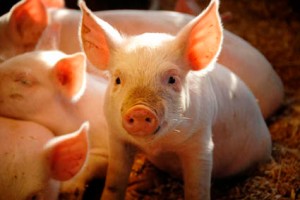This is the second part of a two-part post. Click here for Part I
Hello again, everyone.
This is the final post in my series on Orson Scott Card’s Speaker for the Dead, and the last post of my rotation this month. Last week I started explaining how Card’s Piggies demonstrate his advice about writing aliens from his book How to Write Science Fiction and Fantasy .as I’ve previously discussed in my series on writing aliens. This week I’ll finish that up with the last two points: Culture and Environment. This is a really great book and series (I’ve since gotten into Ender’s Shadow and love it so far) so I highly recommend them! As before, a warning:
WARNING: SPOILERS IMMINENT
Culture: The Problem of Monocultures

As I’ve said before, the concepts of Biology, Culture, and Environment that Card focuses on in his advice are interrelated. But the fact that these elements blur only occurs if you are approaching the writing of your aliens correctly according to Card’s method: if you want to make memorable, believable, and unique aliens, you have to think about these elements of biology, culture, and environment related to each other. To do otherwise is carelessness or flawed in concept.
Culture is a construct, as much in the fictional world as in reality. The way we live here on the east coast of the US is different from how they live in the Congo, for example. Much of this has to do with people having to learn how to adapt to their environment, and our biology dictates our needs and desires within that environment. Other elements are dependent on the rational mind: art, science, law, and other marks of civilization go beyond mere survival to creating a distinct culture. You’re well served to think through all of these things, of course, but there’s one big problem you should avoid as much as possible: monocultures. You’ve seen them in Star Trek and other science fiction, and it’s incredibly lazy. An entire world, one giant, homogeneous culture? Even if you’re trying to convince me that your aliens have formed one world government and nation, it is unbelievable that regional differences would not create a varied culture, even if there are some overarching constants. It’s one of the weaselly ways that stories get around the problem of entire worlds needing to be filled.

That said, the Piggies are, in a way, a monoculture. If the author’s tendency for making monocultures is based in the difficulty of filling an entire world with varied aliens, Card sidesteps the issue quite nicely. The human scientists who encounter the Piggies are not allowed to go out and explore the rest of the planet by order of the International Fleet, for one thing. They can’t verify how the rest of the planet’s Piggies act, so we can’t see if there are significant variations of culture. The Piggies are all stone-age in their technology, so that does limit how much their culture would have differentiated (very low communication technology, for example, restricts the spread of ideas). But the main reason the Piggies make sense as a monoculture is because their lives are tied so closely to their biology. As I mentioned in the last post, the Piggies’ reproduction is tied to the forests they live in. The trees themselves play a role, because in a way the trees are Piggies. I’ll leave the exact mechanism a secret for now (mostly because I can’t think of a way to explain it that makes much sense or doesn’t come off as really weird), but the basics are that Card has come up with a really unique life cycle for his aliens which defines everything they do, from their language, to how they make their tools and weapons, to how they interact with their females. Card’s Piggies are not quite a monoculture, but in this case, Card has shown a narrow exception to his own rule.
Environment: Defining a People’s Limitations
Assuming biology is basically the same across the board, the way your aliens live in different environments should look very different. Think about how humans live on Earth: in the desert, on the tundra, on the coasts and islands… we are very fortunate that Earth’s environment is so beautifully varied. The mistake many SF writers make is that they decide on a particular biome and say “Yeah let’s just make an entire planet like that.” Well, it’s not that easy! First of all, you have to make sure what you’re describing is actually possible. Even if you’ve come up with some contrived reason that the planet makes sense, someone, at some point in your story needs to be curious. It would make sense that the stone-age natives of a cube-shaped planet wouldn’t blink at the revelation of this fact. But it would be silly if no one took issue with this fact and tried to figure out the mystery of it. Barring any crazy, plot-affecting features, if a planet is hospitable for whatever reason, if we are to assume that something can live there, it’s got to be well adapted. If the planet is fairly hospitable, you would be well served to come up with some reasons why it isn’t basically just Earth 2.0 (unless that’s a plot point).

Card’s Piggie homeworld Lusitania is basically what you’d call a “garden world,” being mostly habitable temperate zones with some small polar icecaps. A majority of the landmass is covered with vegetation, and the Piggies live pretty much everywhere. On the surface, it looks a lot like earth, which might otherwise be inconsequential to the plot (it doesn’t always have to be a big deal). But there’s one major difference that makes Lusitania very strange and un-earthlike: it lacks diversity to an extreme. An otherwise fertile planet that, much to the human visitors’ surprise, has very few species. This becomes extremely important to the plot of Speaker for the Dead as the human scientists unravel the mystery of the planet’s lack of numerous animals and plants, and its connection to the Descolada, a terrible plague that was only narrowly cured. I won’t spoil anymore, except to say that Card’s Lusitania is a great example of his interwoven approach, making each aspect of his world reliant on the other. The effect is unique and memorable.
That’s it for this week, and this series! I did my best not to spoil the best parts of the book, so if you haven’t read Speaker for the Dead, definitely pick it up! I’d also recommend How to Write Science Fiction and Fantasy to anyone interested in writing in either genre. Card has a lot a great advice, with great examples from his own work.
